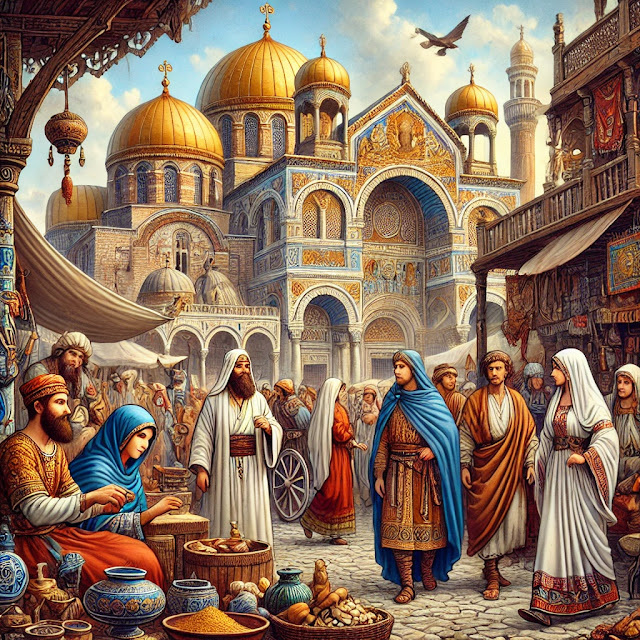The Byzantine Empire, often considered a continuation of the Roman Empire in the East, was a cultural, political, and economic powerhouse that lasted over a millennium. From the 4th to the 15th century, this empire left a significant mark on history, not just through grandiose achievements but also through the intricacies of everyday life. This article takes you deep into the daily lives of Byzantine citizens, exploring their homes, fashion, culinary traditions, and societal structures.
The Byzantine Home: A Blend of Simplicity and Luxury
Household Layout and Furniture
The typical Byzantine home was modest, with a clear divide between the lifestyles of the wealthy and the common folk:
- Middle-Class Homes: Simple in design, middle-class households lacked the furniture we associate with modern homes. Dining sets and comfortable sofas were uncommon, and multipurpose rooms dominated the layout.
- Luxury Homes: In stark contrast, wealthy homes were adorned with luxurious items like silver jugs, intricately designed glassware, and decorative ceramics. These items symbolized affluence and were often displayed to impress guests.
The Importance of Fabrics
Fabrics played a versatile role in Byzantine homes:
- Practical Uses: Fabrics were used as bed covers, curtains, and even for covering walls.
- Egyptian Textiles: Due to their durability, textiles imported from Egypt were highly prized and often repurposed for different household needs.
Beds and Storage Solutions
- Sleeping Arrangements: While the wealthy had opulent beds, the majority of Byzantines slept on mattresses that were laid out at night and stored during the day.
- Chests: These were the primary storage units, used for keeping clothes, jewelry, and personal belongings. The word “sandık” (chest) in Turkish traces its origins back to Byzantine times.
Fashion: A Clear Indicator of Social Hierarchy
Clothing for the Classes
- For the Elite: Rich Byzantines donned silk garments in vibrant colors such as red, purple, and gold, which were expensive and showcased their status.
- For the Commoners: Lower-class citizens wore simple garments made from coarse fabrics, usually in muted tones due to the high cost of dyes.
Gendered Attire
- Women: Women’s clothing was conservative, with long-sleeved dresses and head coverings required in public. Wealthier women accessorized with belts, shawls, and layered tunics.
- Men: Men’s clothing mirrored their societal rank, ranging from basic tunics for workers to embroidered robes for the elite.
Childhood and Leisure: The Byzantine Family
Children’s Toys and Activities
Byzantine children were not overlooked in the material culture of the time:
- Popular Toys: Whistles shaped like animals, wheeled toy horses, and miniature figurines were common.
- Material Evidence: Though many of these toys haven’t survived the centuries, archaeological digs have uncovered a few well-preserved examples.
Family Dynamics
- Families were patriarchal, with the father serving as the head of the household.
- Children were raised according to their family’s societal rank, with boys often educated or apprenticed and girls taught domestic skills.
The Byzantine Culinary Experience
Staples of Byzantine Cuisine
- Bread as a Status Symbol: White bread made from fine flour was considered a luxury and a marker of wealth, while the poor consumed coarser bread made from mixed grains.
- Grains and Legumes: Lentils, beans, and wheat formed the basis of the Byzantine diet.
Meat and Seafood
- Popular Meats: Pork, lamb, and beef were commonly consumed, but the preparation and availability often depended on social class.
- Seafood in Constantinople: Proximity to the Bosphorus made fish a staple in the Byzantine diet. Oysters, clams, and other seafood were highly favored.
Flavors and Spices
- Luxury Ingredients: Spices like saffron, cumin, and cinnamon were reserved for the wealthy due to their high cost.
- Desserts: Byzantine sweets often included preserved fruits, nuts, and honey. These delicacies resembled modern Middle Eastern and Mediterranean desserts.
Trade and Cultural Exchange
Byzantium’s Influence on Europe
- The Fork Revolution: Forks, first used in Byzantine aristocracy, were introduced to Europe by a Byzantine princess in the 10th century, sparking both curiosity and adoption.
- Luxury Goods: Items like ivory carvings, religious manuscripts, and decorative objects were highly sought after in European markets.
Export of Byzantine Artistry
- Byzantine art, particularly ivory works, was a major export. These pieces were used in Europe as book covers and ceremonial items, further cementing Byzantium’s cultural influence.
Marriage, Divorce, and Gender Roles
Marriage Practices
- Monogamy: Monogamy was the standard, though extramarital arrangements occasionally existed among the wealthy.
- Royal Marriages: Imperial marriages often served political purposes, solidifying alliances and ensuring dynastic continuity.
Divorce Laws
- Divorce was legal but heavily restricted:
- Men could divorce their wives for reasons like infidelity or neglect.
- Women had far fewer rights and needed to prove extreme circumstances, such as abandonment or severe misconduct, to seek a divorce.
Art, Music, and Religious Influence
Art and Religious Symbolism
- Byzantine art was rich with religious symbolism, influencing both Eastern Orthodox traditions and later Renaissance art.
- Manuscripts, mosaics, and ivory carvings were integral to Byzantine cultural identity.
Byzantine Music
- Religious chants and hymns dominated Byzantine music. Elements of these compositions have influenced modern Greek and Turkish music traditions, showcasing the empire’s enduring legacy.
The Byzantine Economy: Agriculture and Trade
- Agricultural Backbone: Wheat, barley, olives, and grapes were essential agricultural products. Wine-making and olive oil production were prominent in rural areas.
- Trade Networks: Constantinople’s strategic location made it a hub for trade, linking Europe, Asia, and the Middle East.
Conclusion: A Complex and Vibrant Society
The daily life of the Byzantine Empire was a reflection of its complexity as a society. While the elite enjoyed luxury and art, the common people led simpler lives shaped by necessity. The empire’s influence extended far beyond its borders, leaving a legacy in art, music, cuisine, and culture that continues to resonate today.
Reference; https://youtu.be/8PaJfRuDxZE?si=V3kgKM0yTXcT-2oV Bizans'da Günlük Hayat - Siren Çelik






